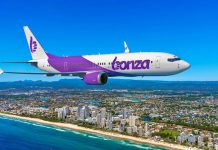A key analysis of wreckage from missing Malaysia Airlines flight MH370 has confirmed a flap from the aircraft’s right wing was stowed, effectively killing off a theory that the plane was in a controlled dive.
The finding is one of several supporting the Australian Transport Safety Bureau’s initial analysis of the crash and indicates the plane is still somewhere close to the seventh arc generated by the final signal between the plane, a geostationary satellite and a ground station in Perth.
A report released today by the ATSB said a further analysis of the signals was consistent with aircraft being in a “a high and increasing rate of descent’’ as it plunged towards the ocean.
Preliminary results of a drift analysis by Australia’s top scientific organisation, the CSIRO, also indicated it was unlikely that debris originated from the south of the current search area.
“The northern most simulated regions were also found to be less likely,’’ it said. “Drift analysis work is ongoing and is expected to refine these results.’’
The analysis of the right, outboard flap section was considered a key piece of evidence and the ATSB sent its findings to manufacturer Boeing to have them verified. It is one of more than 20 items of debris that have been brought to the attention of the investigator and are of interest.
They include a panel section from the right horizontal stabiliser, a piece of engine cowling, a piece of panelling from a closet adjacent to a door and a trailing edge section of the left outboard flap.
Both flap sections had unique identifying numbers linking them, though manufacturing records, to the missing plane and to Malaysia Airlines and were deemed to be “almost certainly’’ from the aircraft.
The flap was examined for any interaction with mechanisms, supports and surrounding components that could indicate its state at the time it was broken off.
Investigators found that damage to components at the inboard end of the outboard was consistent with the flap being retracted and an adjacent flaperon being in the neutral position.
The flap would have been extended had a pilot been preparing the plane for a controlled ditching and the flaperon would been in a down position.
“The possibility of the damage originating from a more complex failure sequence, commencing with the flaps extended, was considered much less likely,’’ the report said.
“With the flap in the retracted position, alignment of the flap and flaperon rear spar lines, along with the close proximity of the two parts, indicated a probable relationship between two areas of damage around the rear spars of the parts.
“This was consistent with contact between the two parts during the aircraft breakup sequence, indicating that the flaperon was probably aligned with the flap, at or close to the neutral (faired) position.’’
The ATSB earlier this year had Boeing run a series of additional scenarios using a sophisticated engineering simulator to determine end-of-flight scenarios.
Simulations that experienced a descent rate consistent with the ranges and timing from the burst frequency offset analysis general hit the water within 15 nautical miles of the seventh arc.
But it also found the aircraft was capable of traveling rearwards from the direction of travel about 21 nautical miles and in some instances it remained airborne for approximately 20 minutes after the second engine flameout.
The report has been released ahead of a three-day First Principles Review Summit which brings together experts and officials from the countries involved in the search for MH370.
Australian Transport Minister Darren Chester said the “First Principles Review Summit” brought together an “extraordinary team of Australian and international experts”’ who had been involved in the search for MH370, to review all the available data and analysis associated with the search.
“The experts will also inform the remainder of the search effort, and develop guidance for any future search operations,’’ he said.
“A report detailing the findings of the review will be released after the meeting.
“Australia, Malaysia, and China continue to work together to find MH370. My thoughts, and the thoughts of all those involved in the summit, remain with the families and friends of the 239 passengers and crew.”
Mr Chester stopped short of ruling out a new search if new information emerged but said an agreement struck in July to end the search once the current 120,000 sq. km area of high probability was swept remained in force unless this happened.
He said it was not his role to second-guess the experts and the Australian government worked in partnership with its Malaysian and Chinese counterparts on these issues.
“Quite rightly, we will continue to explore every bit of information that’s available, and allow the experts from the ATSB in Australia, also the international experience, to inform our efforts,’’ he said
Mr Chester rejected suggestions the search, which he described as an “historic and heroic effort’’, had been pointless.
“We are doing the best we possibly can, and we assembled experts from around the world to reassess the data that’s available to us and then make our decisions,’’ he said.
The search is continuing with two ships now back in the field with remote vehicles capable of re-checking anomalies already mapped and investigating the canyons and ravines in water up to 6kms deep .
The experts reviewing the search include four B777 captains as well as representatives from accident investigators in the US, the UK and Malaysia as well as scientists, manufacturer Boeing and technology companies such as Inmarsat and Thales.
The head of the ATSB search, Peter Foley, said his team had devoted an extraordinary amount of time to solving the MH370 puzzle and was motivated by the desire to find the aircraft for the families and for aviation safety more broadly.
He said the the conference would look again at the evidence gathered so far and any new analysis that was emerging in areas such as drift analysis.
“I think also it’s a chance to look back and see if there’s anything else that we can possibly do to better our understanding, any additional work that can be done to better our understanding about what happened to that aircraft,’’ he said.
Asked if this was a last shot for the searchers, Mr Foley said: “I don’t think there’s a last shot, I think we’re doing what’s a sensible approach at this point and that’s to review all the evidence we have and look at the analysis and see if there’s anything extra that can be done.”
























